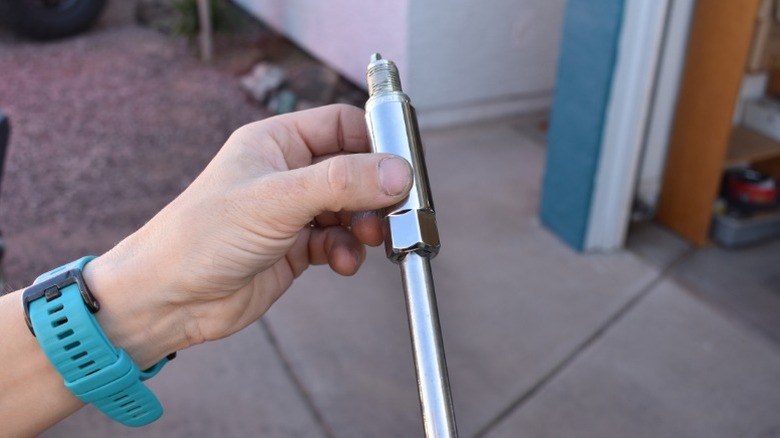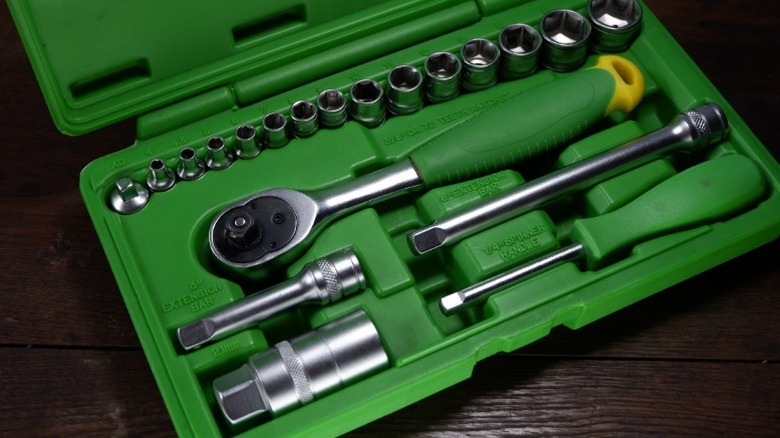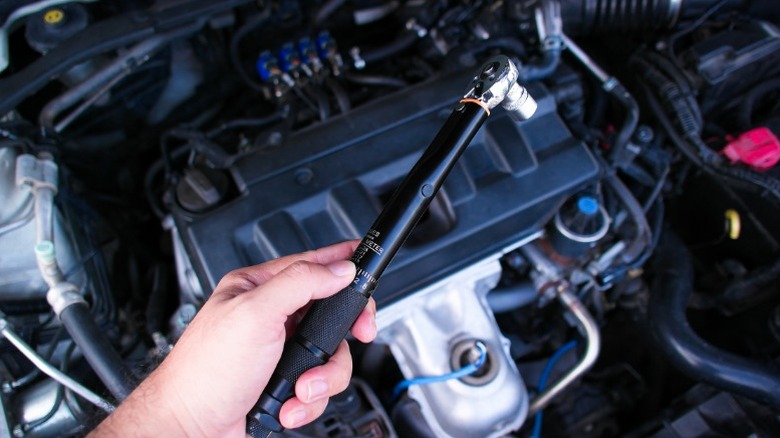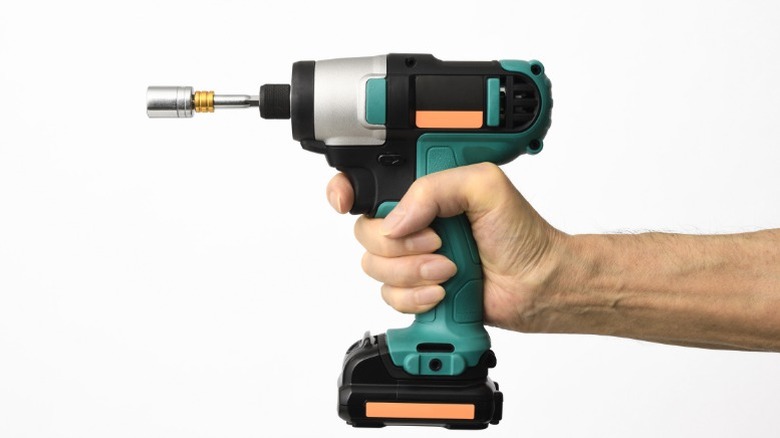What Tools Do You Need To Change A Spark Plug?
We may receive a commission on purchases made from links.
When it comes to engine care 101, a spark plug replacement — also referred to as a tune-up — is an essential task. Spark plugs, as the name implies, provide the spark necessary to ignite the air and fuel mixture in gas-powered internal combustion engines. They're relatively robust components, but they do wear out over time. Replacing them can improve your engine's performance and help increase your gas mileage.
Unlike other forms of auto maintenance, like engine oil replacements and air filter changes, replacing your spark plugs isn't something you have to do too frequently. While many older vehicles using copper spark plugs do require a tune-up every 25,000 to 30,000 miles, most newer cars use platinum or iridium spark plugs. These stronger spark plugs generally last for between 60,000 and 100,000 miles, and many manufacturers don't recommend replacing the spark plugs until the 100,000 mile-mark for modern cars.
Whether your vehicle needs frequent spark plug replacements or not, it can be a great DIY auto job, even with relatively little automotive experience. However, depending on your car, replacing the spark plugs can be pretty tricky. While many four-cylinder engines provide easy access to the spark plugs, some V-style engines, and even some four-cylinder vehicles, have designs that make accessing the spark plugs extremely difficult. That doesn't mean that it's still not a great DIY job. However, you should invest in a vehicle-specific repair manual to help you if you're not experienced with cars. If you're wondering about the basic tools you'll need to change your spark plugs, we've got you covered. From the eponymous spark plug socket to torque wrenches, here's a general list of tools that will come in handy when replacing your spark plugs.
A spark plug socket is an essential tool
As you probably guessed, a spark plug socket is used to remove and install spark plugs. These tools are designed especially for use on spark plugs and often feature a narrow wall and a rubber gasket or magnet to assist with removing spark plugs from the engine. Your spark plug socket size will depend on your vehicle. However, many cars use spark plugs with ⅝-inch or roughly 16-millimeter hex heads. Other vehicles have spark plugs with hex head sizes ranging from 9/16 inches or 14 millimeters to ⅞ inches or roughly 22 millimeters.
Many basic socket sets come with one or two spark plug sockets in the most common sizes. However, it's important to confirm that you have the proper size socket before you start your spark plug replacement. Your vehicle owner's manual is a great place to check for information about the spark plugs that your car uses, as well as other maintenance info like oil change intervals and fluid types.
Once you know that you have the right size spark plug socket, using it is fairly simple. It works like a regular socket, but you will almost assuredly need an extension to fit the socket down the spark plug tube. After you've grabbed onto a spark plug with your socket and extension, you can remove it like you would any other fastener. The rubber gasket or magnet will help prevent the spark plug from falling out of the socket as you remove it from the tube, as well as help you to install new plugs after removing the old ones.
You'll also need a ratchet and socket set with various extensions
In addition to your spark plug socket, you'll also need a variety of different sized standard sockets, a ratchet, and some extensions. That's because even if you drive a car with an engine that allows for easy access to the spark plugs, you'll most likely still have to remove a few components as part of the job. Some of those parts include things like your car's battery, the air filter housing and air intake tubing, engine covers, and more.
Having access to a variety of sockets will make removing these components much easier. Most of the fasteners you'll encounter while performing these tasks should be on the smaller side. A quality socket set containing ⅜-inch drive and ¼-inch drive sockets and ratchets should cover most standard spark plug replacements, as well as various other auto repair and maintenance jobs. You'll also want to have at least a few extensions, which are long rods that connect to ratchets and sockets, allowing you to access parts in tight spots, like spark plug tubes. Many basic socket sets come with a handful of extensions.
However, if you want to up your game a bit, you can purchase a set of wobble extensions, like the Gearwrench Wobble Extension Set. These devices allow your sockets to pivot or wobble a bit and enable you to access much tighter spaces without removing unnecessary components. Finally, depending on your vehicle and how many parts you wish to remove to access the spark plugs, you may want to pick up a set of universal joints, like the Craftsman Universal Joint Socket Set. Like wobble extensions, these devices allow you to access extremely tight spots, often eliminating the need to remove extra parts.
Some pliers may come in handy when changing spark plugs
Quality pliers are an essential part of any mechanic's tool kit. Pliers come in various styles and applications. However, some of the most useful versions when working on cars include things like channel-lock, needle nose, and hose clamp pliers. These devices allow us to grasp things with more force than our hands are capable of providing, and can be supremely handy tools when changing spark plugs. That's because you'll probably have to remove a few components to access the spark plugs. For many cars, gaining access to the spark plugs involves removing things like the air intake tubing, coolant lines, and various other obstructive parts. Many of these components connect to each other using hose clamps, which can be extremely difficult to remove without a solid set of pliers.
If you don't already have access to a handful of pliers of different sizes and types, you may want to consider picking some up before you attempt a DIY spark plug replacement. As mentioned, channel-lock pliers, needle nose pliers, and hose clamp pliers are some of the most popular plier types used in automotive applications. If you can only own one set of pliers, you should think about picking up a solid set of channel-lock pliers, like the Craftsman 2 Piece Groove Joint Set.
This type of pliers will allow you to handle most basic jobs, and you can use them to remove things like hose clamps with relative ease. However, if you're looking for something a bit more extensive, you may want to look into a mechanic's plier set, like the Workpro Pliers Set. These contain everything from channel-lock pliers to snap ring pliers, needle nose pliers, wire cutters, and even a set of oil filter pliers.
A torque wrench is a must-have tool for changing spark plugs
If you're relatively new to DIY auto repair and maintenance, you may not realize that basically every fastener and part of your car must be installed to a specified tightness or torque rating. This applies to virtually every threaded fastener and component, like nuts and bolts, as well as parts like wheel lug nuts and spark plugs. Automakers specify torque ratings for a handful of reasons. If you install a threaded component either too loosely or too tightly, it can cause various problems. For example, installing a lug nut too tightly can warp your brake rotors, while installing one too loosely can create an unstable driving situation and even lead to the loss of a wheel. Spark plugs are not immune to this rule and must be tightened to a specified torque rating to avoid causing damage to the cylinder head or interfering with the ignition and combustion processes.
To avoid over or under tightening fasteners and other threaded parts, use a specialized tool known as a torque wrench. Torque wrenches can come in various styles, but most of them rely on an internal mechanism to prevent the ratcheting head from turning once you reach a certain torque level. Like standard ratchets, torque wrenches are commonly available in ½-inch drive, ⅜-inch drive, and ¼-inch drive varieties.
When it comes to replacing your spark plugs, you'll probably want a ⅜-inch drive torque wrench, like the Tekton ⅜-Inch Drive Micrometer Torque Wrench, available from Amazon. Click-style torque wrenches, like the Tekton product, allow you to set a specified torque rating and then tighten the fastener. When you reach the correct tightness level, the tool will click, and you won't be able to spin it any tighter.
An impact driver is a helpful tool when replacing spark plugs
All of the devices we've covered so far are more or less essential tools for replacing spark plugs. While that can vary slightly, depending on your car, virtually all tune-ups will require the use of the tools mentioned above. However, just because a tool isn't absolutely necessary doesn't mean it's not extremely useful, which leads us to impact drivers. Impact drivers typically come with a ¼-inch chuck, allowing you to connect various bits and attachments, like screwdrivers, nut drivers, Torx bits, and more. These tools are similar to drills, in that they allow us to use rotational force to install or remove fasteners. However, they go one step further than drills by including an interior anvil, which generates impact and creates more force.
While not essential tools for spark plug replacements, they are extremely handy, especially if you drive a vehicle that requires the removal of various components to access the spark plugs. In these cases, an impact driver can drastically reduce the labor required to perform your spark plug replacement by allowing you to quickly zip fasteners on and off to remove things like air intake tubing.
There are many different impact drivers on the market, and not all of them come with lofty price tags. The DeWalt 20V MAX XR Impact Driver is a popular choice among both DIYers and professionals. However, cheaper options exist and may be worth considering for those who plan to use their tools infrequently. The GALAX PRO Impact Driver, available through Amazon, is a budget-oriented tool that comes with solid ratings and should be able to handle most casual DIY jobs, while other stores, like Harbor Freight, are great places to check for a range of impact drivers at different price points.





